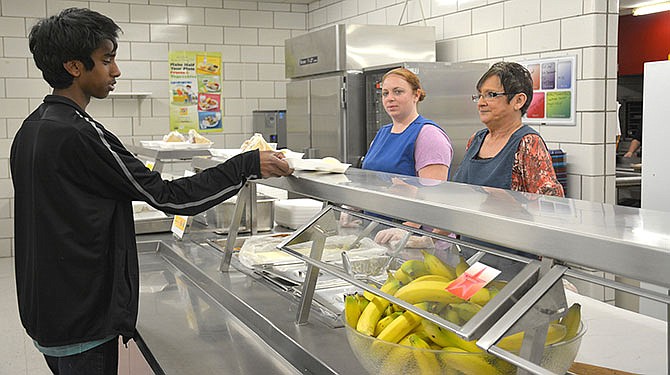In July 2014, Missouri passed Senate Bill 701 that established a farm-to-school program, which launched efforts to not only provide healthier food choices for students, but also to strengthen local farming economies.
That legislation laid the groundwork for task forces to be created and funding to be made available to the programs.
By January of this year, legislation has been proposed to expand the reach of that bill to require participating institutions to purchase at least 10 percent of their food products locally by December 2019.
Here in Fulton, the school lunch program was already running ahead of the curve as Rhonda Fletcher, director of food services for Fulton Public Schools, had begun trying to source locally grown food as early as 2011.
"I'm a gardener," said Fletcher. "I see the positive results of using fresh fruits and vegetables, so I decided to try to participate."
Nationally, interest in farm to school programs has been around for several years as student health and obesity issues have gained media attention. According to the State Farm to School Legislative Survey 2002-2014, Missouri is well ahead of neighboring states (with the exception of Iowa, which is very similar) in their efforts to bring healthy, local foods to students.
Fletcher said that she started out by simply choosing Missouri grown apples from vendors she was already using. Then she began looking for other locally and regionally grown foods, saying she drives to Clark each summer to haul cases of peaches back for the students.
"When the mandate first started, the older students who hadn't been forced to take certain foods before, just got mad," said Fletcher, who added that she often watched students pick up a piece of fruit and deposit it directly into the trash.
"But I notice that the younger students who have been exposed to the fresh fruits and vegetables for a while, tend to choose those options now," said Fletcher.
Everyone agrees that offering fresh foods is great for student health, and supporting local producers helps the economy of a community, but the program and the 10 percent mandate don't come without their challenges.
"The program exposes kids to great tasting produce and creates life-long habits of healthy eating," said Cindy Deblauw of the University of Missouri Extension Office. "But we don't have enough producers. Demand is far outstripping supply."
Deblauw referenced a website called AgriMissouri Classifieds where schools can list what they are looking for and producers can list what they have. But a quick look at the site also confirms her concerns. Of the first 45 listings from the fall of 2015, only two of those were producers. All the rest were schools looking to purchase local foods.
"We think that farmers are not posting because they are already committed to a school and are operating at capacity to what they can provide," said Deblauw.
Fletcher expressed similar concerns saying that it is difficult to find producers, but there is also a limitation to her options because Missouri's growing season flourishes over the months that school is not in session.
One of her producers, Webster Davis, agrees.
"The biggest hurdle one will find with the farm-to-school program is that the school year and the growing season in Missouri do not match," wrote Davis in an email. "The school year starts at the end of August and runs through the end of May. Frost dates in Missouri will seriously harm, if not ruin, a lot of produce during this time frame."
Davis, a member of the Farmer Veteran Coalition, is trying to create a business plan, however, to meet the needs of the local schools. He says he has attended multiple seminars on small-scale farming and is looking to grants to assist him in his plan.
"Bringing the Homegrown by a Hero program into the school lunchroom is one of my many goals to increase participation by veteran farmers," said Davis.
Another challenge for Fletcher is simply time. As the program expands, food service providers must not only find producers, but make certain those producers follow positive food-safety practices in relation to chemical use and cleaning.
"With a two-person staff, it will become difficult to meet the required demands," said Fletcher.
"Many of the options right now can be met through the salad bar," said Deblauw, but as she looks down the road, she does see challenges in the future.
"Schools may have difficulty finding people to do the food preparation," she said. "People don't have the skills needed any more when it comes to cooking. We've really become a society where we just heat things up."
Currently, much of what FPS provides is heat and serve, though chili and a few other options are made from scratch.
"Chicken nuggets and pizza are still student favorites," said Fletcher. "But I do see a difference in what students are choosing at the salad bar."
And though there are challenges, she sees the benefits, both to student health and the local farm economy.
"It'll be tough," she said. "But it's a means to an end."

